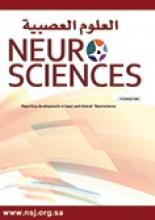Abstract
OBJECTIVE: Tetanus although rare, has not been eradicated and continues to present from time to time. Early diagnosis and management may be life saving. This study aims to evaluate all patients admitted with the clinical diagnosis of tetanus in King Abdul-Aziz Hospital Jeddah, Kingdom of Saudi Arabia over the last 3 years.
METHODS: All patients admitted with the clinical diagnosis of Tetanus in King Abdul-Aziz Hospital and Oncology Center from January 2000 through to December 2002 were retrospectively reviewed and data was analyzed to determine the demographic features, clinical details, management, and outcome of treatment.
RESULTS: A total of 11 patients were admitted during this period. All patients were diagnosed in the emergency room by clinical examination. Their ages ranged from 22-68 years. The immunization status of these patients was unknown. All of them were males with 4 of them being injection-drug users. Eight patients had a definite history of injury mainly involving the lower limbs. The incubation period ranged from 5-30 days. Nine patients required mechanical ventilation for a period varying from 2-4 weeks. All patients received Tetanus Immunoglobulin with a dose ranging from 500-3000 unit. The spasms were mainly controlled by diazepam infusion with a maximum dose of 480mg/day. Magnesium sulphate was used in 6 patients to control spasms and autonomic dysfunction. Metronidazole was used in addition to Benzyl Penicillin in 9 patients. Out of the 11 cases 10 were discharged home and only one patient died 6 days after admission.
CONCLUSION: Tetanus is still a problem in developing countries. It is a potentially fatal disease, without early medical intervention. Primary immunization and scheduled booster immunization are important preventive measures that have greatly reduced the incidence of tetanus.
- Copyright: © Neurosciences
Neurosciences is an Open Access journal and articles published are distributed under the terms of the Creative Commons Attribution-NonCommercial License (CC BY-NC). Readers may copy, distribute, and display the work for non-commercial purposes with the proper citation of the original work.






